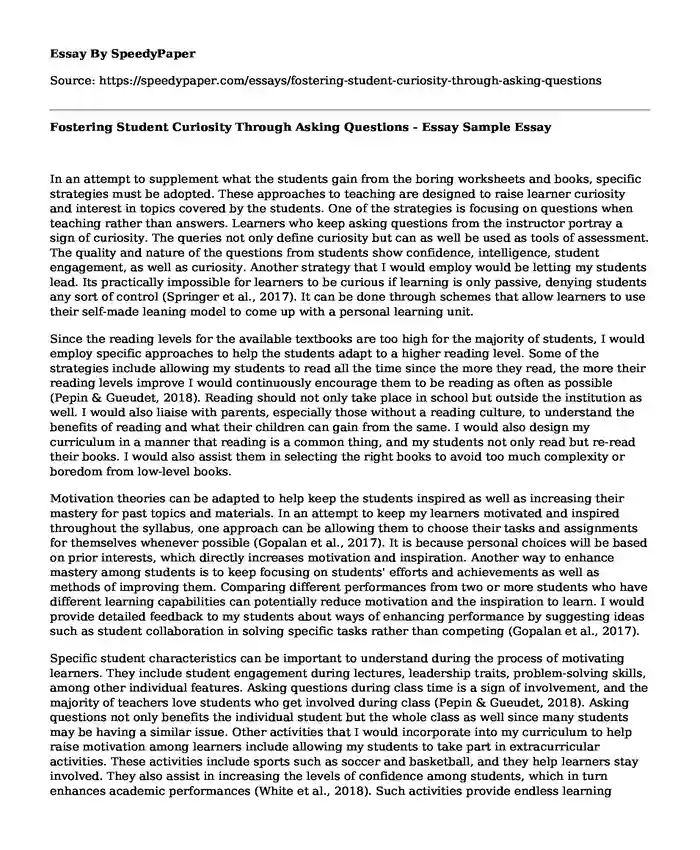In an attempt to supplement what the students gain from the boring worksheets and books, specific strategies must be adopted. These approaches to teaching are designed to raise learner curiosity and interest in topics covered by the students. One of the strategies is focusing on questions when teaching rather than answers. Learners who keep asking questions from the instructor portray a sign of curiosity. The queries not only define curiosity but can as well be used as tools of assessment. The quality and nature of the questions from students show confidence, intelligence, student engagement, as well as curiosity. Another strategy that I would employ would be letting my students lead. Its practically impossible for learners to be curious if learning is only passive, denying students any sort of control (Springer et al., 2017). It can be done through schemes that allow learners to use their self-made leaning model to come up with a personal learning unit.
Since the reading levels for the available textbooks are too high for the majority of students, I would employ specific approaches to help the students adapt to a higher reading level. Some of the strategies include allowing my students to read all the time since the more they read, the more their reading levels improve I would continuously encourage them to be reading as often as possible (Pepin & Gueudet, 2018). Reading should not only take place in school but outside the institution as well. I would also liaise with parents, especially those without a reading culture, to understand the benefits of reading and what their children can gain from the same. I would also design my curriculum in a manner that reading is a common thing, and my students not only read but re-read their books. I would also assist them in selecting the right books to avoid too much complexity or boredom from low-level books.
Motivation theories can be adapted to help keep the students inspired as well as increasing their mastery for past topics and materials. In an attempt to keep my learners motivated and inspired throughout the syllabus, one approach can be allowing them to choose their tasks and assignments for themselves whenever possible (Gopalan et al., 2017). It is because personal choices will be based on prior interests, which directly increases motivation and inspiration. Another way to enhance mastery among students is to keep focusing on students' efforts and achievements as well as methods of improving them. Comparing different performances from two or more students who have different learning capabilities can potentially reduce motivation and the inspiration to learn. I would provide detailed feedback to my students about ways of enhancing performance by suggesting ideas such as student collaboration in solving specific tasks rather than competing (Gopalan et al., 2017).
Specific student characteristics can be important to understand during the process of motivating learners. They include student engagement during lectures, leadership traits, problem-solving skills, among other individual features. Asking questions during class time is a sign of involvement, and the majority of teachers love students who get involved during class (Pepin & Gueudet, 2018). Asking questions not only benefits the individual student but the whole class as well since many students may be having a similar issue. Other activities that I would incorporate into my curriculum to help raise motivation among learners include allowing my students to take part in extracurricular activities. These activities include sports such as soccer and basketball, and they help learners stay involved. They also assist in increasing the levels of confidence among students, which in turn enhances academic performances (White et al., 2018). Such activities provide endless learning chances in leadership and often teach learners the concept of teamwork.
References
Gopalan, V., Bakar, J. A. A., Zulkifli, A. N., Alwi, A., & Mat, R. C. (2017, October). A review of the motivation theories in learning. In AIP Conference Proceedings (Vol. 1891, No. 1, p. 020043). AIP Publishing LLC. https://aip.scitation.org/doi/pdf/10.1063/1.5005376
Pepin, B. E. U., & Gueudet, G. (2018). Curriculum resources and textbooks in mathematics education. Encyclopedia of mathematics education. https://www.narcis.nl/publication/RecordID/oai:pure.tue.nl:publications%2F43b9a57d-6dfa-42b2-9a01-c4f3ab11749f
Springer, S. E., Harris, S., & Dole, J. A. (2017). From Surviving to Thriving: Four ResearchBased Principles to Build Students' Reading Interest. The Reading Teacher, 71(1), 43-50. https://ila.onlinelibrary.wiley.com/doi/pdf/10.1002/trtr.1581
White, T., Scott Jr, L. D., & Munson, M. R. (2018). Extracurricular activity participation and educational outcomes among older youth transitioning from foster care. Children and Youth Services Review, 85, 1-8. https://www.sciencedirect.com/science/article/pii/S0190740917306114
Cite this page
Fostering Student Curiosity Through Asking Questions - Essay Sample. (2023, Oct 15). Retrieved from https://speedypaper.com/essays/fostering-student-curiosity-through-asking-questions
Request Removal
If you are the original author of this essay and no longer wish to have it published on the SpeedyPaper website, please click below to request its removal:
- My Techniques and Tips to Making Oneself Study - Free Essay in Education
- Education Essay Sample - Ph.D. Admission Request
- Free Essay: My Experience of the English Language
- Essay Sample: Ludlow-Taylor Elementary School and the Taylor Art and Culture Centre Program
- Essay Example: Why I Want to Become a Nurse Practitioner
- E-Learning: Digitalization Enhancing Education & Training - Essay Sample
- Teachers' Communication: TKES Standard 10 - Paper Example
Popular categories





